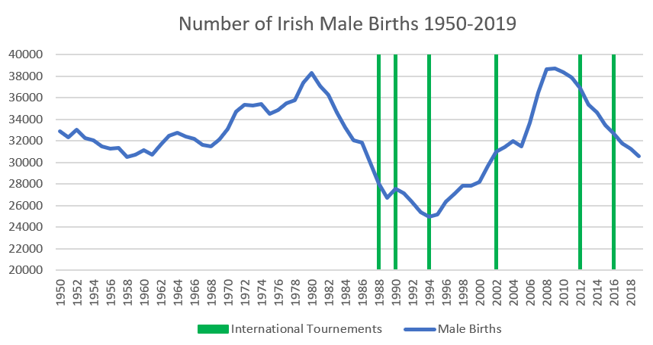A phrase that I’ve always liked is demography is destiny. The phrase is attributed to French sociologist and philosopher Auguste Comte. The idea behind the saying is simple enough, the shape of the population shapes the population’s future. In his book The Demographic Cliff, Harry Dent Jr. describes how demographics can impact on future levels of economic activity. He gives many examples of how generations with proportionately high birth rates go on to increase economic activity a disproportionate amount 20 or 30 years after their births. The book got me thinking about whether or not this could be applied to the case of sport, specifically soccer, in Ireland.
If you look at the ages of players in national football teams you can see that most are in their 20s. A few veterans will be in their early 30s but as a rule of thumb, international soccer is a young man’s game. This means that when a footballer is born it will take them around 20 odd years before they go on to represent their national team. The Irish men’s national team reached their first ever major tournament in 1988 which means that we would be looking at the birth rates for Irish males in the mid to late 1960s. Coincidentally, this period of time just happens to be an era of high births rates for Irish males. By 1963, Irish male births had reached levels similar to the baby boom period in the late 1940s and early 1950s. The number of male births in Ireland continued to increase upwards from the 1960s up until 1980 where it peaked at 38,267. It seems suspicious that the most fertile period for male births was from the early 1960s to 1980 and Ireland also just happened to begin qualifying for major international tournaments in the very late 1980s, 1990s, and early 2000s. Around the time when these players would be coming of age.
This is illustrated in the below graph which shows the number of Irish males born in blue and the years the Irish national men’s team played in a major international tournament in green from 1950-2019.
It seems demographic change has quite a decent level of explanatory power over Irish sporting success. Now it does have to be said that demographic change seems to offer little explanation for Ireland’s poor participation in major international tournaments up until 1988. This is most likely as a result of the famous ban which the GAA had in place on foreign sports up until 1971. This meant that people who played non-Irish sports like soccer would have been banned from playing our national sports like hurling and Gaelic football. It is very likely that this may explain Ireland’s lack of participation in major soccer tournaments up to this stage. None the less demographic change seems to explain Irish success fairly well from the 1980s on.
Lastly, it should be noted that there is no way this demographic change could predict Ireland’s success on the pitch exactly. Historical demographic change can only give us an indication as to the era in which we may be most likely to qualify for a major tournament because we will have a relatively larger stock of potential players to pick from. Considering this, it seems a relatively safe bet that the Irish men’s team will start to improve toward the end of this decade and go on to qualify for the 2030 World Cup and the 2032 Euros, which will both take place just over 20 years after the record high number of 38,682 male births set in 2008. COYBIG!

 RSS Feed
RSS Feed